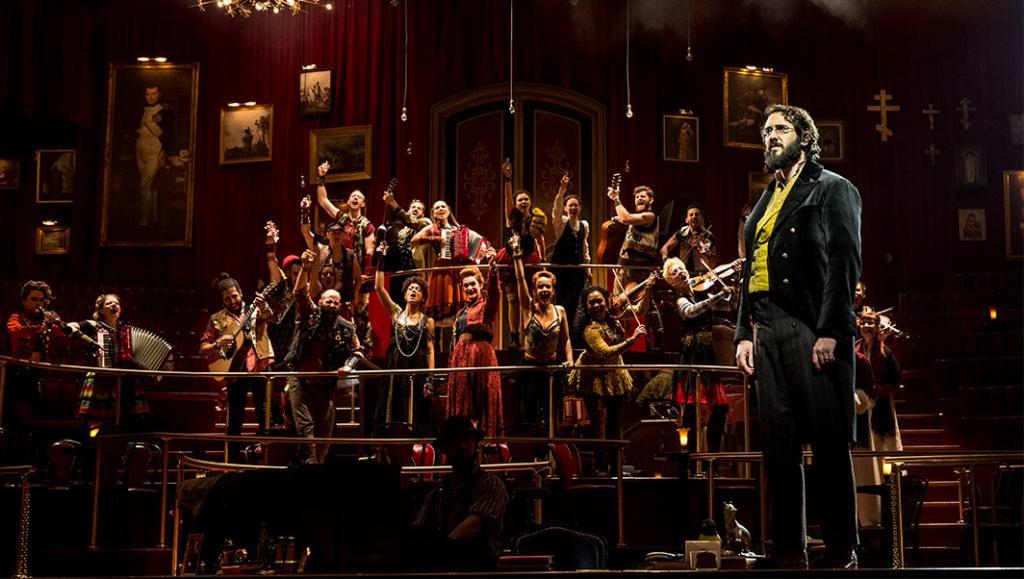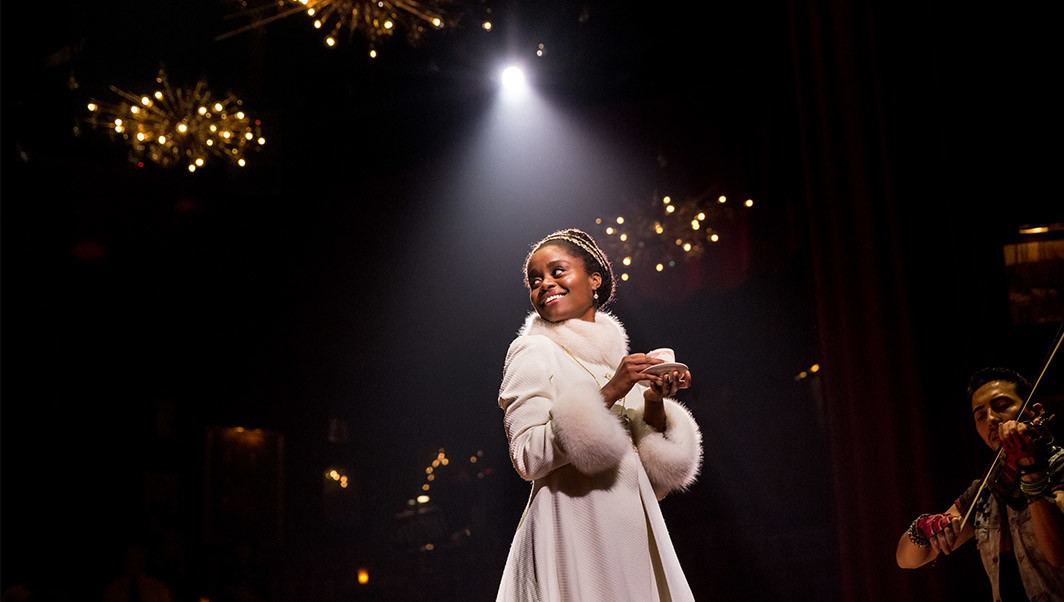To See or Not to See: Natasha, Pierre & the Great Comet of 1812

When you step through the entrance to the Imperial Theater to see Natasha, Pierre & the Great Comet of 1812, you aren’t just entering a theater; you’re entering a new world.
Set designer Mimi Lien has transformed every nook and cranny. The lobby boasts cement walls covered in Russian advertisements, posters, and spray paint. The theater itself is bursting with red velvet wall hangings, painted portraits in gilded frames, and gorgeous star-burst-like chandeliers. Walkways of stage snake through the middle of the orchestra and staircases lead from the mezzanine down to the front orchestra so actors can nimbly traverse floors and use the whole house as their stage.
The traditional stage itself has had an intensive re-working. Banquets of audience seats sit in a semi-circle and onstage tables like at a cabaret are scattered in between walkways for the actors. In the middle sits part of the orchestra, recessed so only the music director’s head (and Josh Groban’s for most of Act 1) along with the top of a piano is visible. It is, surely, the most unique theater currently on Broadway.
My only complaint about Natasha, Pierre & the Great Comet of 1812 is a minor one about the building itself. Having seen the show in its previous incarnation in a much smaller house is where my complaint originates from. The show did not have the exact same air of intimacy that made it so thrilling the first time around which left me wondering how exactly the show would be different sitting up in the mezzanine (it goes without saying that a seat on stage would be wonderful). Don’t get me wrong: Rachel Chavkin’s direction and staging was inventive and fostered the notion that the audience was an integral part of the story.
Everything else about the almost entirely sung-threw show was fabulous. Natasha, Pierre & the Great Comet of 1812 is a small piece pulled from the larger and epic story of Leo Tolstoy’s War and Peace. Writer/composer Dave Malloy’s hyper-focus on one strand of the story makes it more accessible to audiences and allows more minor characters shine.
We meet young countess Natasha (Denée Benton) as her fiancé, Prince Andrey (Nicholas Belton) leaves for the war front of Russia’s defense against Napoleon’s invasion. Left on her own, she goes to stay in Moscow society at her godmother Marya’s (Grace McLean) along with her prim cousin, Sonya (Brittain Ashford). Once there, she meets Andrey’s cold sister, Mary (Gelsey Bell) and tyrannical father (also Nicholas Benton) and they all instantly dislike each other. Natasha then exepreinces the decadence of Moscow society at the Grand Opera where she encounters handsome Anatole (Lucas Steele)…who ignites desire in her that is new and exciting. With the help of his promiscuous sister, Helene (Amber Gray)–who is lovelessly married to Pierre (Josh Groban), but flirting with rascally Dolokhov (Nick Choksi)–Anatole is able to weasel his way into Natasha’s heart. But Anatole has a secret—he’s already married. What results is heartbreak, ruin, and, eventually, the kindling of a future hope between hapless Pierre and downtrodden Natasha.
The performances are all-around fantastic (and complimented by bright, creative costumes by Paloma Young). Josh Groban’s extraordinary voice and the way he carried himself created a physical and emotional dejected-ness to Pierre that was palpable. Denée Benton was all sparkle and light as Natasha. Her growth from childlike innocence to foolhardy young woman to stunned adult was engrossing. Lucas Steele’s Anatole was the comically peacocking tempter that never failed to get a laugh or smirk out of the audience. Particularly endearing, both musically and vocally, was Brittain Ashford’s Sonya during her solo “Sonya Alone”. On the opposite end of the spectrum, Amber Gray’s jazzy “Charming” solo was also impressive. I could go on and on for each actor, each song. Indeed, each actor soared during their individual songs—as did the chorus members tasked with staying connected not just to the show, but also to audience members. This company is bursting with delightful talent.
Finally, I would be remiss if I did not mention the music on its own. There are strains of traditional-sounding Slavic music; there are more modern pop tones; there are lovely ballads. Musically, the blend of different genres and styles work together to create numbers that are fresh, original, catchy, and touching.
With almost every aspect of Natasha, Pierre & the Great Comet of 1812 incredibly vivid and exhilarating, it’s definitely a show not to be missed.
Natasha, Pierre & the Great Comet of 1812 is playing at the Imperial Theater. Click here for more information.
Photo Credits: Chad Batka



Discussion about this post